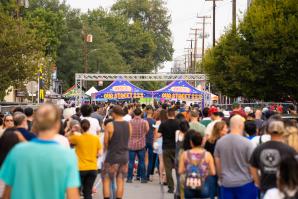One of Sacramento’s successful native daughters had a homecoming this week — almost 90 years overdue. Long before Greta Gerwig or Brie Larson, there was Betty Inada, a Japanese American jazz singer who sought fame in Japan in a time when American screens and stages had little space for Asian women.
On May 14 at the Sofia theater, the Sacramento Asian Pacific Film Festival screened her 1936 film “Whispering Sidewalks,” which offers a glimpse into Japan’s nascent jazz scene and Inada’s mercurial career. State historian and Preservation Sacramento President William Burg suggested in his introductory speech that the film may have never before been screened in its star’s hometown. “Welcome home, Betty,” he said.
Born in Sacramento in 1913, Inada grew up in the city’s then-thriving Japantown, which was demolished in the 1950s to make way for Capitol Mall. Surrounded by the diverse West End, Japantown had its own jazz scene with clubs and bands run by and for the Japanese American community — but it wasn’t big enough for Inada’s ambitions. After a stint with a vaudeville troupe in Los Angeles, she embarked for Tokyo, joining an influx of foreign-born musicians ready to meet Japan’s burgeoning demand for the new American sound.
“Whispering Sidewalks,” released just three years after Inada left California, was written as a vehicle for the singer and her co-star, the American-trained tap dancer Saburo Nakagawa. Inada plays a fictionalized version of herself, Betty Yoshida, as she arrives in Japan to media frenzy, falls prey to con-artist managers, and gets back on her feet with the help of fellow musicians who see her potential.
The 84-minute run time includes several bilingual versions of contemporary American hits, including “St. Louis Blues,” “La Cucaracha” and “Dinah.” Inada sings the English verses with crisp California diction, and her American accent lingers in the Japanese verses — according to Burg, she spoke little Japanese before she arrived in the country. But the film’s catchiest tune is its original opening track, a jaunty ode to jazz and youth that the fictional Betty Yoshida writes for her new musician friends.
After the film, the screen was tucked up to make way for the Harley White Jr. Orchestra, a jazz ensemble based in Sacramento. Their set included the original piece “Whispering Sidewalks,” which band leader Harley White Jr. composed in honor of Inada. White first encountered her story while helping his friend, the late writer Steve Archer, research characters for a detective novel set in Sacramento in the 1920s and ‘30s. “Her story was more interesting than anything we could come up with,” he says.
White learned that Berkeley Art Museum and Pacific Film Archive held a copy of “Whispering Sidewalks,” one of only two films starring Inada that have not been lost. He was able to arrange a visit to watch the film with Archer, Burg and his father, but bringing it to Sacramento was a more complicated process that ended up taking a decade.
“To be honest, for Harley and I, part of the challenge was convincing them that in Sacramento, we had a place where this movie could be shown. They assume, ‘What, you’re going to show it off the side of a gas station?’” Burg says. “So part of the challenge, often, with holdings that are outside of Sacramento, is convincing people that Sacramento has cultural institutions that can put on this kind of event.”
Jason Jong, a musician friend of White and founder of the Sacramento Asian Pacific Film Festival, helped make the connections and raise the funds that ultimately convinced BAMPFA the city could host the film. He says a Japanese American film archivist at BAMPFA, Jon Shibata, was sympathetic to the project and instrumental in its success.
“The next path is possibly trying to screen it at other events, maybe showing it in the Bay Area and expanding audiences, hoping to share the story of this Sacramentan, Japanese American jazz vocalist and actress,” Jong says. He also hopes it will drive interest in Sacramento’s lost neighborhoods and the fomenting Rebuild Sacramento Japantown project.
White has his sights set on screening the film in public schools around Sacramento as part of a greater emphasis on music education, especially jazz music. “Jazz is for everyone, and Betty shows that,” he says.
Inada’s success continued beyond the film. She remained a popular performer in Japan until the 1950s and returned to Sacramento in 1958 to open a Japanese restaurant, only to find that most of the community she remembered was gone — decimated by the wartime internment and dispersed by the demolition of Japantown. She soon moved to Los Angeles and died there in 2001. At age 80 in 1993, she told author George Yoshida “I have no regrets. I did what I wanted to do in my own small way,” as quoted in his 1997 book “Reminiscing in Swingtime: Japanese Americans in American Popular Music.”
Burg says that Inada’s story — and its fictional mirror in “Whispering Sidewalks” — can encourage Sacramento’s current generation of ambitious young people to pursue their dreams, both within the region and beyond it. “Part of the study of the past is to inspire the next generation of stars, the next generation of talented people,” he says, noting that one of the region’s main exports is “bored but talented” teenagers. “They’re going to get inspired the most by people who they recognize and stories that resonate with them, and so the more examples we have, the better.”
“Whispering Sidewalks” will be available on demand at the Sacramento Asian Pacific Film Festival website until May 29.
Correction May 17, 2023: A previous version of this article stated that BAMPFA received screening fees for the SAPFF screening of “Whispering Sidewalks.” While it may receive fees for future screenings, it did not charge a fee for the SAPFF screening.
Recommended For You

Tastes of the Past
A Farm-to-Fork Festival event pays homage to the Sacramento neighborhoods demolished in the name of urban renewal
The West End Revival, a ticketed dinner organized by the Last
Supper Society, evoked the people and businesses that were
displaced to make way for the Capitol Mall Project — a cautionary
tale for modern developers and city planners envisioning the
future of Sacramento.

An Event for the People, by the People
The first Our Street Night Market since 2019 showcased Sacramento’s diversity
After the three-year pandemic hiatus, Our Street has grown into a tightly choreographed event that brings in visitors as far afield as the Bay Area. We asked Yellow Brick Group co-owner Shawn Kahan for his post-event takeaways.

Neighborhood Favorite: Taiwan Best Mart
A homemade sausage business grows into a popular restaurant
“It all started with the sausage,” says Christine Chang, the
second-generation owner of Taiwan Best Mart.

Art Exposed: Beti Masenqo
The musician-singer-songwriter blends folk and rock with the Ethiopian songs of her childhood
When she performs, singer and songwriter Beti Masenqo leaves this earthly plane in a way that seems entirely effortless.



